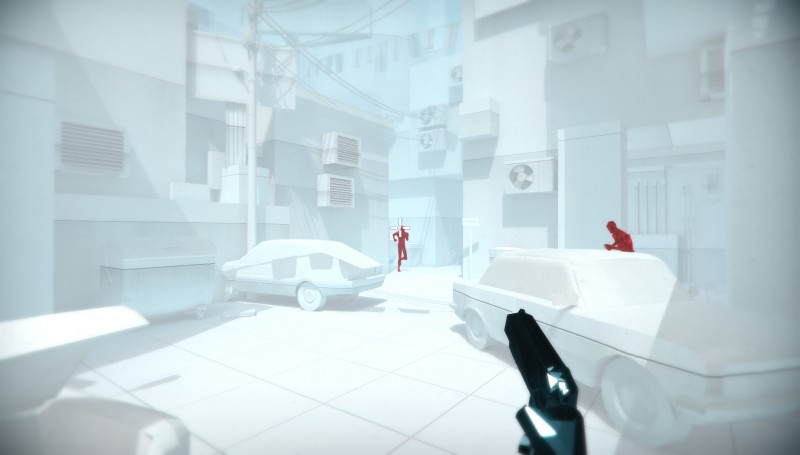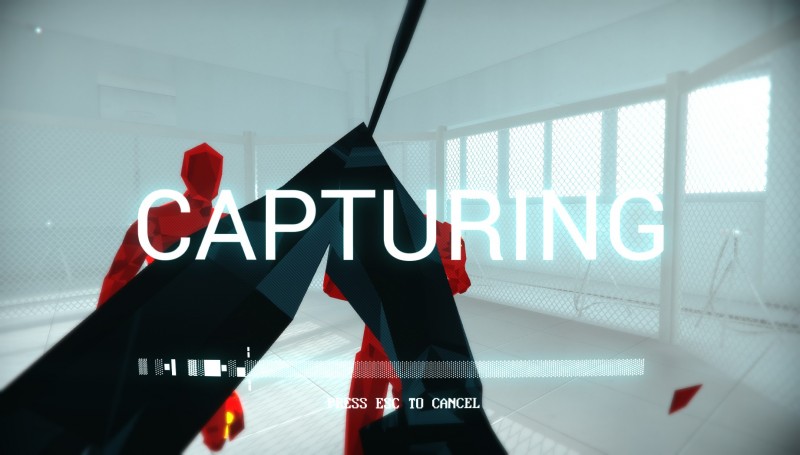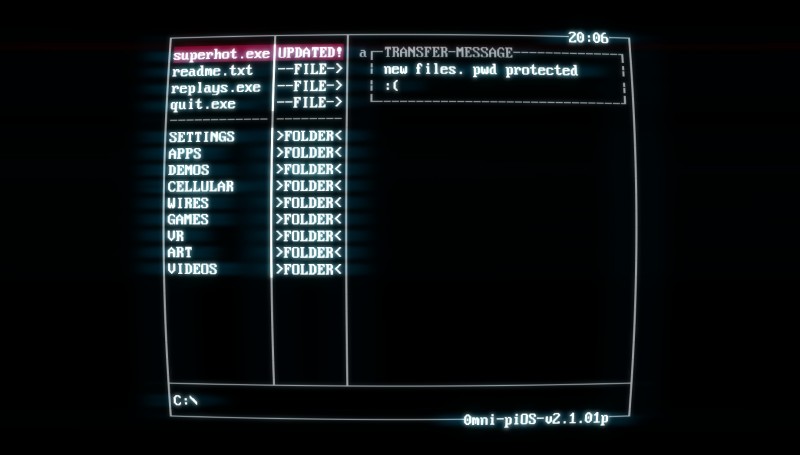Superhot Review
"When you are super hot, every time is bullet time."
Superhot is a fascinating new take on the first-person shooter genre. It combines elements of first-person shooters with elements of strategy by slowing everything in the game to bullet time.
You start each level often surrounded by several enemies, creatively called “red guys,” and proceed to murder the ever-living heck out of them until you have fully cleared the room. Throughout each level, you will often find a wide variety of weapons from guns and swords to telephones and briefcases.

In some ways,
Superhot is just as much a strategy or puzzle-y game as it is a first-person shooter. Everything in the levels move very slowly, including enemies and bullets, but it all speeds up when you move or perform certain actions like turning or shooting. This bullet time gives you a fair amount of time to get your bearings and react to everything going on, but you have to be extremely careful as you move. Stand still, and you can see the bullets whizz right past you. Turn too much, though, and they will pass through your skull fast as, well, a bullet.
Some of the levels are monitor-shatteringly difficult at first, but once you finally complete each level, you are rewarded with a full, “real-time” recap of everything you did. Most of it is animated fairly well, creating a fast-paced little movie that looks very reminiscent of those stick-figure animation videos. It is fun to think that it way you who sort of created that epic fight scene. You can even upload those fight scenes onto a website that the SUPERHOT Team created called killstagram.com.

The one thing that would have made those scenes better would be if there was a camera control option in the editing process. Also, there is an annoying voice-over yelling SUPER HOT with those same words flashing over the screen while the animation is taking place.
Unfortunately,
Superhot is graphically unimpressive. All of the walls, floors, and non-interactive objects are plain white. All of the weapons are plain black. All of the enemies are the same red polygonal meshes. There is a thematic reason for this overtly barebones art style, and the animation tries to make up for the bare graphics a little bit (especially with how the enemies explode when you kill them), but in the end, the game is still not very pretty.
The story of
Superhot is rather impressive, in spite of how short it turned out to be. Between levels, there are segments that take place on the screen of an old-style computer, where “you” talk to some hacker friend. The story gets kind of meta in a way that starts to blur the line between you as the character and you as the player. The way the story plays out is almost as much as fascinating as the gameplay is.
The sound quality goes back to the same sort of barebones theme that the graphics follow. There is no music throughout
Superhot’s main game, although there is some in one of its mini-games.
Superhot instead focuses entirely on the sound effects created by gunfire, weapon swings, broken glass, etc. I suppose there could be an argument for the lack of music as helpful in dealing with the situations presented in each level. Still, there could have been a little more effort in the music department.
 Superhot
Superhot currently comes with a $24.99 price tag, which I must admit feels a little bit heavy given just how barebones the graphics and sound quality are and how short the story is as a whole. It takes no more than a few hours to finish the story, and from there you are left with a speedrun mode and an endless mode to play with. After an hour or so with those, there is really not much replay value. Even after enjoying the gameplay and the story, I find it hard to recommend this game for much more than $10-15. Waiting for a Steam sale or something will likely be a safer bet.
Superhot is, by and large, a very neat concept of a game. The slow and deliberate pacing that this game provides really does feel like a breath of fresh air in terms of gameplay. The addition of that strategic element creates a neat new type of gameplay that I would really love to see more of. Its story also (sort of) breaks new ground by adding a level of immersion that, to me, made me uncertain whether I was playing as a character or whether the character was me, the player. Unfortunately,
Superhot is held back quite a bit by oversimplified graphics and sound effects. Even the graphics would be somewhat excusable, however, if it weren’t for the fact that the game is just too short to be worth its asking price. Overall, this game feels more “a little warm” than super hot.
Pros
- Interesting gameplay
- Great mash-up of FPS and strategy
- Intriguing story
Cons
- Barebones graphics
- Boring and annoying sound
- Too short
 In some ways, Superhot is just as much a strategy or puzzle-y game as it is a first-person shooter. Everything in the levels move very slowly, including enemies and bullets, but it all speeds up when you move or perform certain actions like turning or shooting. This bullet time gives you a fair amount of time to get your bearings and react to everything going on, but you have to be extremely careful as you move. Stand still, and you can see the bullets whizz right past you. Turn too much, though, and they will pass through your skull fast as, well, a bullet.
Some of the levels are monitor-shatteringly difficult at first, but once you finally complete each level, you are rewarded with a full, “real-time” recap of everything you did. Most of it is animated fairly well, creating a fast-paced little movie that looks very reminiscent of those stick-figure animation videos. It is fun to think that it way you who sort of created that epic fight scene. You can even upload those fight scenes onto a website that the SUPERHOT Team created called killstagram.com.
In some ways, Superhot is just as much a strategy or puzzle-y game as it is a first-person shooter. Everything in the levels move very slowly, including enemies and bullets, but it all speeds up when you move or perform certain actions like turning or shooting. This bullet time gives you a fair amount of time to get your bearings and react to everything going on, but you have to be extremely careful as you move. Stand still, and you can see the bullets whizz right past you. Turn too much, though, and they will pass through your skull fast as, well, a bullet.
Some of the levels are monitor-shatteringly difficult at first, but once you finally complete each level, you are rewarded with a full, “real-time” recap of everything you did. Most of it is animated fairly well, creating a fast-paced little movie that looks very reminiscent of those stick-figure animation videos. It is fun to think that it way you who sort of created that epic fight scene. You can even upload those fight scenes onto a website that the SUPERHOT Team created called killstagram.com.
 The one thing that would have made those scenes better would be if there was a camera control option in the editing process. Also, there is an annoying voice-over yelling SUPER HOT with those same words flashing over the screen while the animation is taking place.
Unfortunately, Superhot is graphically unimpressive. All of the walls, floors, and non-interactive objects are plain white. All of the weapons are plain black. All of the enemies are the same red polygonal meshes. There is a thematic reason for this overtly barebones art style, and the animation tries to make up for the bare graphics a little bit (especially with how the enemies explode when you kill them), but in the end, the game is still not very pretty.
The story of Superhot is rather impressive, in spite of how short it turned out to be. Between levels, there are segments that take place on the screen of an old-style computer, where “you” talk to some hacker friend. The story gets kind of meta in a way that starts to blur the line between you as the character and you as the player. The way the story plays out is almost as much as fascinating as the gameplay is.
The sound quality goes back to the same sort of barebones theme that the graphics follow. There is no music throughout Superhot’s main game, although there is some in one of its mini-games. Superhot instead focuses entirely on the sound effects created by gunfire, weapon swings, broken glass, etc. I suppose there could be an argument for the lack of music as helpful in dealing with the situations presented in each level. Still, there could have been a little more effort in the music department.
The one thing that would have made those scenes better would be if there was a camera control option in the editing process. Also, there is an annoying voice-over yelling SUPER HOT with those same words flashing over the screen while the animation is taking place.
Unfortunately, Superhot is graphically unimpressive. All of the walls, floors, and non-interactive objects are plain white. All of the weapons are plain black. All of the enemies are the same red polygonal meshes. There is a thematic reason for this overtly barebones art style, and the animation tries to make up for the bare graphics a little bit (especially with how the enemies explode when you kill them), but in the end, the game is still not very pretty.
The story of Superhot is rather impressive, in spite of how short it turned out to be. Between levels, there are segments that take place on the screen of an old-style computer, where “you” talk to some hacker friend. The story gets kind of meta in a way that starts to blur the line between you as the character and you as the player. The way the story plays out is almost as much as fascinating as the gameplay is.
The sound quality goes back to the same sort of barebones theme that the graphics follow. There is no music throughout Superhot’s main game, although there is some in one of its mini-games. Superhot instead focuses entirely on the sound effects created by gunfire, weapon swings, broken glass, etc. I suppose there could be an argument for the lack of music as helpful in dealing with the situations presented in each level. Still, there could have been a little more effort in the music department.
 Superhot currently comes with a $24.99 price tag, which I must admit feels a little bit heavy given just how barebones the graphics and sound quality are and how short the story is as a whole. It takes no more than a few hours to finish the story, and from there you are left with a speedrun mode and an endless mode to play with. After an hour or so with those, there is really not much replay value. Even after enjoying the gameplay and the story, I find it hard to recommend this game for much more than $10-15. Waiting for a Steam sale or something will likely be a safer bet.
Superhot is, by and large, a very neat concept of a game. The slow and deliberate pacing that this game provides really does feel like a breath of fresh air in terms of gameplay. The addition of that strategic element creates a neat new type of gameplay that I would really love to see more of. Its story also (sort of) breaks new ground by adding a level of immersion that, to me, made me uncertain whether I was playing as a character or whether the character was me, the player. Unfortunately, Superhot is held back quite a bit by oversimplified graphics and sound effects. Even the graphics would be somewhat excusable, however, if it weren’t for the fact that the game is just too short to be worth its asking price. Overall, this game feels more “a little warm” than super hot.
Superhot currently comes with a $24.99 price tag, which I must admit feels a little bit heavy given just how barebones the graphics and sound quality are and how short the story is as a whole. It takes no more than a few hours to finish the story, and from there you are left with a speedrun mode and an endless mode to play with. After an hour or so with those, there is really not much replay value. Even after enjoying the gameplay and the story, I find it hard to recommend this game for much more than $10-15. Waiting for a Steam sale or something will likely be a safer bet.
Superhot is, by and large, a very neat concept of a game. The slow and deliberate pacing that this game provides really does feel like a breath of fresh air in terms of gameplay. The addition of that strategic element creates a neat new type of gameplay that I would really love to see more of. Its story also (sort of) breaks new ground by adding a level of immersion that, to me, made me uncertain whether I was playing as a character or whether the character was me, the player. Unfortunately, Superhot is held back quite a bit by oversimplified graphics and sound effects. Even the graphics would be somewhat excusable, however, if it weren’t for the fact that the game is just too short to be worth its asking price. Overall, this game feels more “a little warm” than super hot.